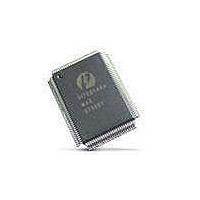PI7C7300DNAE Pericom Semiconductor, PI7C7300DNAE Datasheet - Page 67

PI7C7300DNAE
Manufacturer Part Number
PI7C7300DNAE
Description
IC PCI-PCI BRIDGE 3PORT 272-BGA
Manufacturer
Pericom Semiconductor
Datasheet
1.PI7C7300DNAE.pdf
(107 pages)
Specifications of PI7C7300DNAE
Applications
*
Interface
*
Voltage - Supply
*
Package / Case
272-PBGA
Mounting Type
Surface Mount
Maximum Operating Temperature
+ 85 C
Minimum Operating Temperature
- 40 C
Mounting Style
SMD/SMT
Operating Supply Voltage
3 V to 3.6 V
Supply Current (max)
660 mA
Lead Free Status / RoHS Status
Lead free / RoHS Compliant
Available stocks
Company
Part Number
Manufacturer
Quantity
Price
Company:
Part Number:
PI7C7300DNAE
Manufacturer:
Pericom
Quantity:
135
Company:
Part Number:
PI7C7300DNAE
Manufacturer:
MAX
Quantity:
5 510
9.1
9.2
9.2.1
Pericom Semiconductor
PRIMARY PCI BUS ARBITRATION
PI7C7300D implements a request output pin, P_REQ#, and a grant input pin, P_GNT#,
for primary PCI bus arbitration. PI7C7300D asserts P_REQ# when forwarding
transactions upstream; that is, it acts as initiator on the primary PCI bus. As long as at
least one pending transaction resides in the queues in the upstream direction, either
posted write data or delayed transaction requests, PI7C7300D keeps P_REQ# asserted.
However, if a target retry, target disconnect, or a target abort is received in response to a
transaction initiated by PI7C7300D on the primary PCI bus, PI7C7300D de-asserts
P_REQ# for two PCI clock cycles.
For all cycles through the bridge, P_REQ# is not asserted until the transaction request
has been completely queued. When P_GNT# is asserted LOW by the primary bus arbiter
after PI7C7300D has asserted P_REQ#, PI7C7300D initiates a transaction on the
primary bus during the next PCI clock cycle. When P_GNT# is asserted to PI7C7300D
when P_REQ# is not asserted, PI7C7300D parks P_AD, P_CBE, and P_PAR by driving
them to valid logic levels. When the primary bus is parked at PI7C7300D and
PI7C7300D has a transaction to initiate on the primary bus, PI7C7300D starts the
transaction if P_GNT# was asserted during the previous cycle.
SECONDARY PCI BUS ARBITRATION
PI7C7300D implements an internal secondary PCI bus arbiter. This arbiter supports eight
external masters on secondary 1 and seven external masters on secondary 2 in addition to
PI7C7300D. The internal arbiter can be disabled, and an external arbiter can be used
instead for secondary bus arbitration.
SECONDARY BUSARBITRATION USING THE INTERNAL
ARBITER
To use the internal arbiter, the secondary bus arbiter enable pin, S_CFN#, must be tied
LOW. PI7C7300D has eight/seven secondary bus 1/2 request input pins, S1_REQ#[7:0],
S2_REQ#[6:0], and has eight/seven secondary bus 1/2 output grant pins, S1_GNT#[7:0],
S2_GNT#[6:0], to support external secondary bus masters. The secondary bus request
and grant signals are connected internally to the arbiter and are not brought out to
external pins when S_CFN# is HIGH.
The secondary arbiter supports a 2-sets programmable 2-level rotating algorithm with
each set taking care of 8 requests/ grants. Each set of masters can be assigned to a high
priority group and a low priority group. The low priority group as a whole represents one
entry in the high priority group; that is, if the high priority group consists of n masters,
then in at least every n+1 transactions the highest priority is assigned to the low priority
group. Priority rotates evenly among the low priority group. Therefore, members of the
high priority group can be serviced n transactions out of n+1, while one member of the
low priority group is serviced once every n+1 transactions. Error! Reference source not
found. shows an example of an internal arbiter where four masters, including
PI7C7300D, are in the high priority group, and five masters are in the low priority group.
Using this example, if all requests are always asserted, the highest priority rotates among
Page 67 of 107
3-PORT PCI-TO-PCI BRIDGE
November 2005 - Revision 1.01
PI7C7300D












